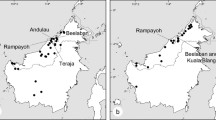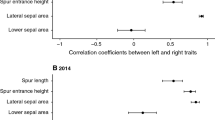Abstract
Competition for pollination may occur between pollinator-sharing sympatric plants and this may cause character displacement of their floral traits. We examined this possibility by comparing flower morphology of the sympatric population of Clerodendrum trichotomum and its co-flowering congener, C. izuinsulare, with that of the allopatric populations. The two species were visited in common by such insects as diurnal hawkmoths, bees, swallowtails and nocturnal hawkmoths, and were pollinated nocturnally as well as diurnally. Interspecific pollen transfer can occur by sharing pollinators; however, they did not hybridize when artificially pollinated. Flower size, including stamen and style lengths, is larger in C. trichotomum with an overlap in range. The style of C. izuinsulare in the sympatric population was significantly shorter than that in the allopatric population, while there was no significant difference in style length between the allopatric and the sympatric C. trichotomum. This seems to facilitate avoidance of interspecific pollen transfer in the sympatric population.
Similar content being viewed by others
Author information
Authors and Affiliations
Corresponding author
Additional information
Ken Inoue was killed in an accident on July 28, 2003, during his research trip in Sakhalin.
Rights and permissions
About this article
Cite this article
Miyake, T., Inoue, K. Character displacement in style length between pollinator-sharing Clerodendrum trichotomum and C. izuinsulare (Verbenaceae). Plant Syst. Evol. 243, 31–38 (2003). https://doi.org/10.1007/s00606-003-0059-1
Received:
Published:
Issue Date:
DOI: https://doi.org/10.1007/s00606-003-0059-1




